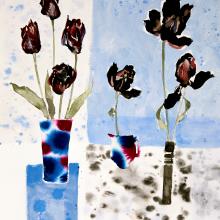
Jenny Matthews – exhibiting with Janet Melrose this month at the Union Gallery – is fascinated by the forms and colours of flowers, which she depicts with often scientific attention to detail. The realism with which she renders light reflected from or diffused through leaves and petals has something of the botanist's unswerving focus, but is never merely observational or emotionally lifeless.
How does she manage this? To be honest, I'm not sure – but here are three suggestions.
First, Matthews is passionate about what she paints, and her insistence upon accuracy reflects not a desire 'simply' to re-create Nature, but a wish to convey her personal astonishment at and admiration of its constituents: 'There is something magical about discovering an exquisite insect or flower in a landscape,' she writes. 'The painting is already there and I am attempting to record my wonder at the creation on paper'.
Second, for all her claims to be merely a witness to these marvels, Matthews artfully composes the subjects of her work into balanced wholes. Her floral forms – their lines, their blocks and intensities of colour – create a rhythm which both binds and individuates them. Interestingly, she speaks in the exhibition notes of her own growing sense in these works of 'the connections between painting and music, and the imagery which can be conjured up through these media'. Certainly, her works are no random assemblages of wildflowers as you might find them in the field.
Third, Matthews is as interested in the paint on her paper or canvas as she is in the subject matter. She thinks of her creations as simultaneously figurative and abstract. This approach is very apparent in the paintings on show here, with several shimmering between the two in ludic juxtapositions of light and texture. My personal favourites are when these contrasts are at their most intense, as in the beautifully varied textures of Black Tulip Still Life (above), and the curious shifts from flatness to depth, from artificial to natural in Blue Sky and Blue Feather (below).
[img_assist|nid=2992|title=|desc=|link=node|align=middle|width=640|height=507]
Matthews's feathers, I must say, are an absolute delight.
Spurtle last reviewed the work of Janet Melrose in May 2011, at which point we wrote of her exploring 'the delicate threads between human experience and Nature; the present and remembered past; imagination, so-called reality and possible alternatives'. Similar themes appear in this latest exhibition, although – following a recent trip to Italy – the works on offer are heavily influenced by the life and teachings of St Francis of Assisi.
Much of the the St Francis legend derives from stories gathered in the Fioretti – or 'little flowers' – a collection assembled after his death in the early 13th century. Here are recorded his respect for poverty, his love of Nature, and belief in the duty of all creatures to praise God. In the hierarchical Middle Ages, his philosophy was remarkable for the degree of parity it accorded all living things.
Melrose's pleasingly pared-down paintings here record a spiritual journey, ostensibly Christian to judge by the repeated use of symbolic cross and crosier, but equally open-minded to more or less orthodox religious experience in other cultures. She describes it as a 'pilgrimage and quest to find and connect with something bigger than self'.
The central figure is some kind of priest, usually accompanied by a dog and sometimes by a horse, and occasionally by a red fox which for Melrose symbolises spontaneous personal thought 'leading the way, or lagging behind not knowing which way to go'. Birds – to whom St Francis once famously preached as if to siblings – often figure in the works, either singly and at the margins, or centrally as in the subtly ethereal In the Company of Birds (below).
[img_assist|nid=2995|title=|desc=|link=node|align=middle|width=487|height=640]
Melrose's style here is refreshingly simple, avoiding showy technique in order to focus on what really matters. She concentrates on fords, crossing-points and thresholds. She delights in the mutual curiosity of different species, their capacity to know each other and – as in Sleeping under the Stars – appreciate each other's companionship.
[img_assist|nid=2996|title=|desc=|link=node|align=middle|width=472|height=640]
I found that these paintings grew on me. I like them for the modest way in which they tackle huge questions without fanfare. I appreciate the way they don't preach or offer simplistic solutions, instead recording the simple pleasures of a life in progress.
My favourite was Meeting of Ideas (below), a mysteriously evocative painting despite – or perhaps because of – the apparent absence of painterly intervention. As for St Francis, less here is more. AM
[img_assist|nid=2997|title=|desc=|link=node|align=middle|width=472|height=640]
[Jenny Matthews and Janet Melrose, RSW will continue at the Union Gallery, 45 Broughton Street, until 4 June.]